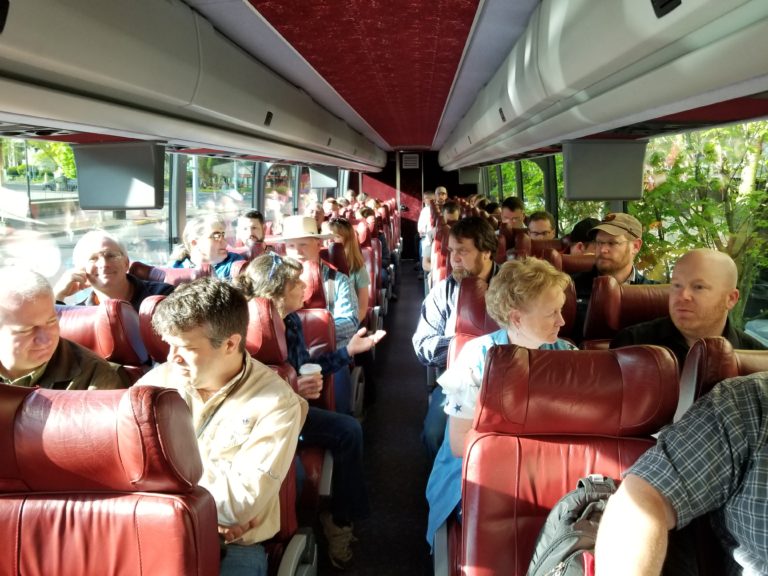Folks started showing up in the Grand Hotel Lobby bright and early on Thursday morning. The weather forecast looked perfect for a day out in the countryside. Old friends were greeted, and new acquaintances were made. If I had a dime for every time I heard someone say, “You’re Kyla! Nice to put a face to your name” I’d have a pocket full of dimes.
We boarded the bus and van and headed out for our first stop, a Driller Radish production field. On the way there we picked up growers, Mike Coon and his son KC to get a firsthand account of how Driller Radish is produced. Mike talked about the seeding rate, time of planting, and harvest. Jerry talked about how most Daikon Radishes originate from Japanese vegetable seed varieties and there are many brands of daikon radish marketed but few actual varieties. Driller is a brand, but we keep a stable supply of seed stock and sell only what we contract produce from that seed stock, maintaining a consistent product.

The next stop was probably the most anticipated of the day, if not by the guests, certainly by the GO-Team… FIXatioN Balansa Clover Production Field! Jerry talked about the breeding background of FIXatioN and some of the success stories of farmers and hunters around the country. Exceptional cold tolerance and tremendous forage production were at the top of the desired trait list when the selection work began about 13 years ago. The grower talked about how they love growing FIXatioN as part of their crop rotation as it cleans up weed problems and contributes hundreds of pounds of free nitrogen. One of the interesting things Mike said was that FIXatioN is an extremely small seeded crop and they generally lose about 1/3 of the seed when they combine the windrows. Given the mind-blowing amount of biomass produced by FIXatioN, the windrows are enormous but with FIXatioN’s hollow stems, it dries down quickly. Our guests waded out into the field and were amazed by the crunching sound under their feet. It felt like we were doing real damage to the field by walking on it but Mike assured us that in a couple of days, you wouldn’t even be able to tell where we walked. One of the guests proudly showed off a 4-leaf FIXatioN plant!

The next stop was at the Corvallis PMC (plant material center) where the very knowledgeable Anne Young-Matthews gave us a tour of her trials. In her trial plots were planted different varieties of Crimson Clover, Hairy Vetch, Balansa Clover, Berseem Clover, Cereal rye, and Black Oats. It was eye-opening for many of the guests to see what a big difference there is between the varieties that were entered in the trials. Differences in maturity, stand health, ground cover %, and forage output were right there for all to see. Jerry promised that he had not been out there at night fertilizing the GO varieties because they stood out as the best in every species we had an entry in. From my perspective, the most dramatic examples of plant breeding for superior products were in Crimson Clover where our Kentucky Pride was much later maturing and had doubled for growth of “Dixie” and the Balansa Clover plots where FIXatioN made us wonder if it was even the same specie as the competing Australian bred varieties.
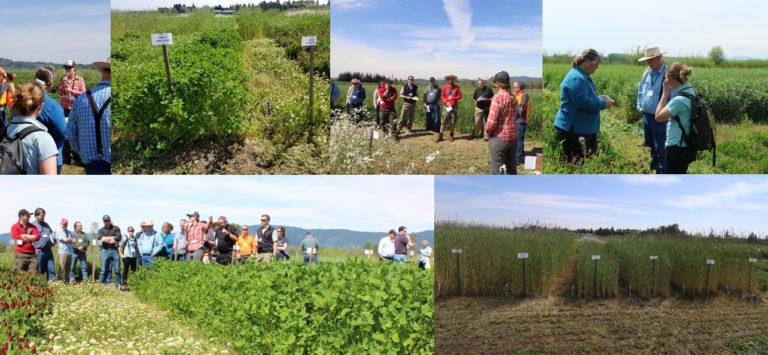
By this time the sun was beating down on us, so we had a nice break in under some shade tree and enjoyed a delicious lunch.
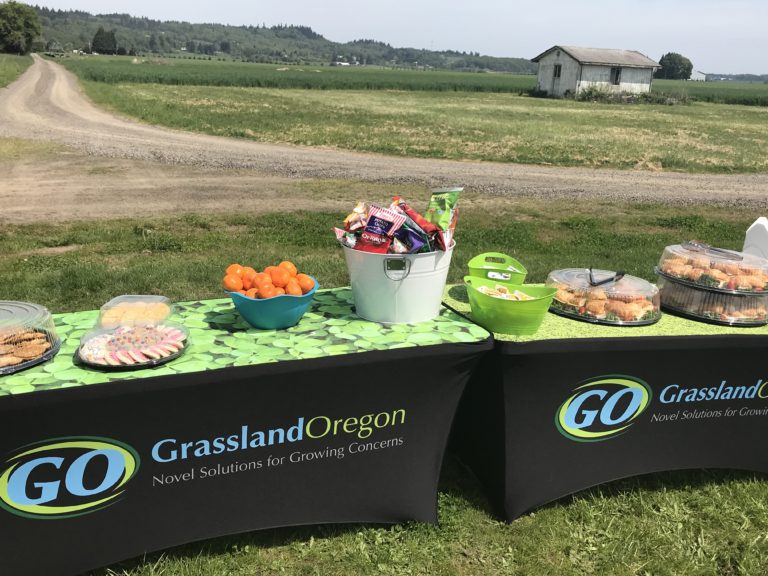
Next up was a visit to a Frosty Berseem Clover production field. Jerry spoke about the breeding work behind Frosty and how it has revolutionized the use of Berseem Clover in the colder climates of the United States. Frosty is the only Berseem clover variety with sufficient cold tolerance to allow it to be frost-seeded into declining alfalfa stands in the Midwest. But…cold tolerance isn’t its only valuable trait as it is widely used as a forage companion crop with ryegrass or cereal grains in the Southern States. GO-Team Field Rep Collin Scott dug up a few plants to pass around to show off the Nitrogen-producing nodules.

The last production field we visited was Dixie Crimson Clover. Dr. Chris Reberg-Horton and Jerry talked a bit on this stop about the differences in varieties and how what used to be Dixie several decades ago is now much different. Many of the crimson grower’s contracts produced different crimson varieties for Italian companies years ago. Some of these varieties proved to be excellent seed yielders and were later produced with saved seed and sold as Dixie. One of Dixie’s traits used to be that was its excellent at re-seeding itself. When you buy VNS or Dixie crimson clover, you never really know what you are going to get. Will it be early maturing or late? Will it be an aggressive re-seeder?
We were running a little ahead of time and Archery Summit Vineyard wasn’t quite ready for us yet so we stopped to see a seed cleaning plant. This was a nice surprise and many of the guests had never seen how grass seed is cleaned.

Our last stop of the day was at Archery Summit Vineyard. What a great way to end a full day of touring. We started with a glass of Rose to quench our thirst then headed out to the vines and listened to the Vineyard manager talk about the benefits of cover crops and what they have done to improve the soil at Archery Summit. After that, we went into the caves underneath the winery where it was cool and comfortable to enjoy some appetizers and do some wine tasting. This was a great time to visit with the other guests about what they had learned during the field tours and to do some networking.
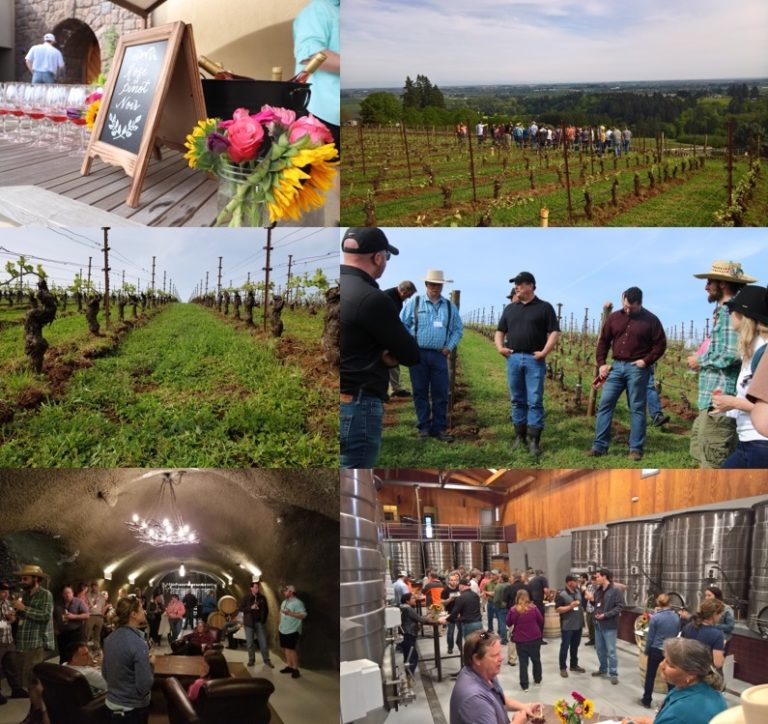
Friday morning, we had the privilege of listening to cover crop and soil health presentations:
Dr. Chris Reberg-Horton- North Carolina State University talked about breeding work he is doing on allelopathy in cereal rye. He further drove home the variety matter message.
Julia Gaskin from the University of Georgia spoke about the Cover Crop Nitrogen Availability Calculator she has developed.
Dr. Dan Davidson couldn’t be with us but he teleconferenced in and spoke about the important role of microbes in soil health and the tools available to measure this metric.
Jay Brandt from Brandt Family Farms in Ohio shared his family’s experiences with the use of cover crops in their operation.
Dr. Rob Myers from the University of Missouri/SARE talked about the educational role SARE plays with the various cover crop councils and the need for a Western Cover Crop Council.
Lastly, there was a very interesting panel discussion with the speakers sharing their experiences.

We boarded the bus again around noon and headed out to the GO Office and Research Farm. We had a great BBQ lunch of burgers and hot dogs cooked up by Phill then headed out to the GO Research Farm. Here, Dr. Ryan Haden, Ohio State University, talked about inter-seeding into corn and Jerry spoke about the GO products and what we are working on for the future.

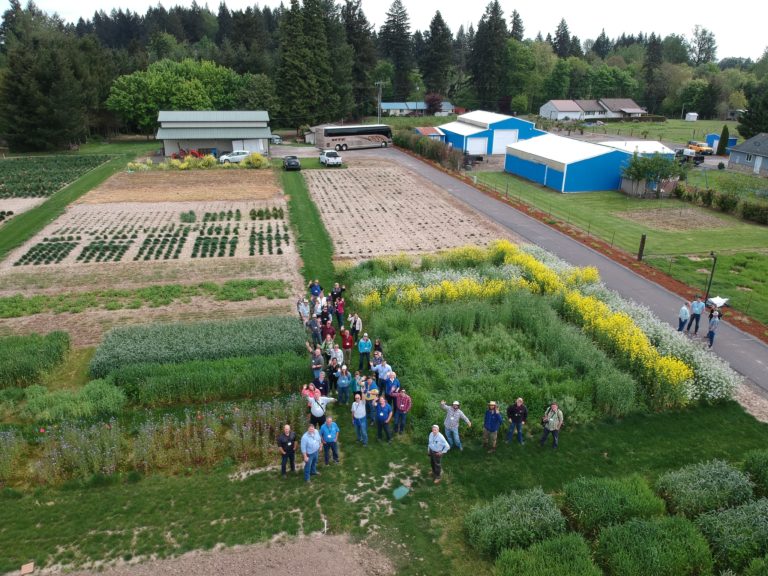
After that, it was back to the hotel and time to head home. The trip home gave us all the time to reflect on a great event and all that was shared by our hosts, The GO-Team!
For a printable, PDF version of this blog, click below.
GO In-Depth, 2018. PDF

